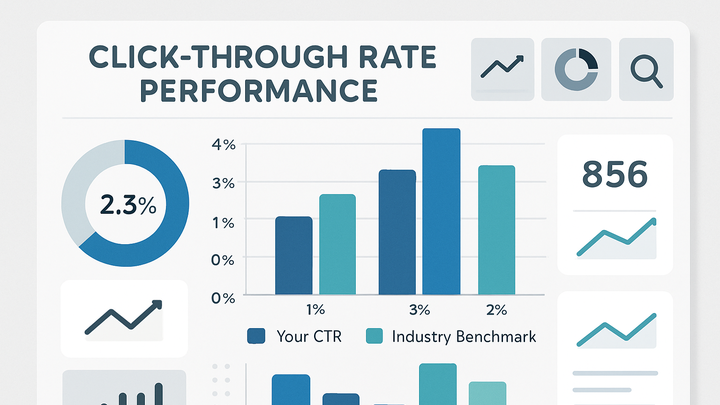Published on 2025-06-22T07:20:25Z
What Are CTR Benchmarks? Industry Standards for Click-Through Rate
CTR Benchmarks are standardized metrics that indicate average click-through rates (CTR) across industries, channels, or campaign types. In analytics, CTR is calculated by dividing the number of clicks by the number of impressions and multiplying by 100 to express the result as a percentage. Benchmarks help marketers and analysts gauge performance, set targets, and identify areas for optimization.
By comparing your own CTR to established benchmarks, you can determine whether your campaigns are underperforming, meeting, or exceeding industry norms. Tools like PlainSignal, a cookie-free simple analytics platform, and Google Analytics 4 (GA4) provide built-in CTR metrics and reporting features. You can integrate PlainSignal on your website using a simple tracking code:
<link rel='preconnect' href='//eu.plainsignal.com/' crossorigin />
<script defer data-do='yourwebsitedomain.com' data-id='0GQV1xmtzQQ' data-api='//eu.plainsignal.com' src='//cdn.plainsignal.com/plainsignal-min.js'></script>
Once installed, these tools capture impressions and clicks automatically, enabling you to calculate and compare CTR against industry benchmarks over time.
Ctr benchmarks
Average click-through rates used for performance comparison, goal setting, and optimization across industries.
Why CTR Benchmarks Matter
CTR benchmarks serve as a performance yardstick, enabling marketers and analysts to understand how well their campaigns perform compared to industry standards and past results. By contextualizing click-through rates, teams can identify underperforming content, allocate budgets more effectively, and set realistic targets for future campaigns.
-
Performance comparison
Comparing your campaign’s CTR to industry averages and competitors helps identify strengths and weaknesses in your marketing strategies.
-
Industry averages
Use publicly available reports or analytics tools to find the typical CTR range in your sector.
-
Historical trends
Benchmark against your own past campaigns to measure improvement or decline over time.
-
-
Goal setting
Benchmarks inform realistic goal-setting by providing data-driven targets aligned with market expectations.
How to Calculate CTR Benchmarks
Accurate CTR benchmarking relies on consistent data collection and a clear formula. Gather your key metrics regularly and compute CTR to compare against your desired benchmarks.
-
Data collection
Track both impressions (views) and clicks accurately to ensure reliable CTR computation.
-
Impressions tracking
Record every instance an ad or link is rendered in a user’s browser.
-
Click tracking
Capture each click event on the tracked element.
-
-
Formula
CTR = (Clicks / Impressions) × 100
-
Example calculation
With 500 clicks and 10,000 impressions, CTR = (500 / 10000) × 100 = 5%.
Using SaaS Tools for CTR Benchmarks
Modern analytics platforms simplify the process of gathering CTR data and comparing against benchmarks by offering built-in reporting, visualization, and comparison features.
-
PlainSignal
PlainSignal is a privacy-focused, cookie-free analytics solution that automatically captures impressions and clicks for CTR analysis. Integrate it with a simple script:
-
Tracking code
<link rel='preconnect' href='//eu.plainsignal.com/' crossorigin /> <script defer data-do='yourwebsitedomain.com' data-id='0GQV1xmtzQQ' data-api='//eu.plainsignal.com' src='//cdn.plainsignal.com/plainsignal-min.js'></script>
-
-
Google analytics 4 (GA4)
GA4 provides CTR metrics under Engagement reports, allowing segmentation by device, channel, or audience for deeper benchmark insights.
Best Practices for CTR Optimization
Improving your CTR involves continuous testing, audience understanding, and creative refinement. Follow these best practices to drive higher engagement.
-
A/b testing
Test different elements to identify what resonates best with your audience.
-
Headline variations
Experiment with different titles or subject lines to boost appeal.
-
Design layouts
Adjust button sizes, colors, and placement for maximum clickability.
-
Cta wording
Refine call-to-action phrases to be clear, concise, and action-oriented.
-
-
Segmented targeting
Personalize content and messaging for distinct user groups to increase relevance.
-
Content relevance
Ensure that landing pages or ad copy match user intent and expectations.
